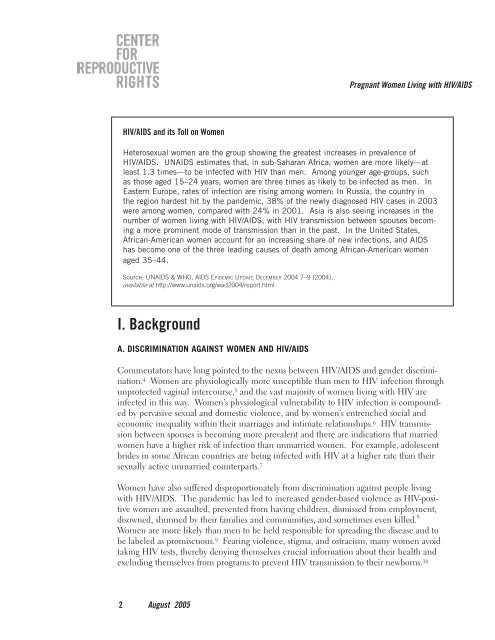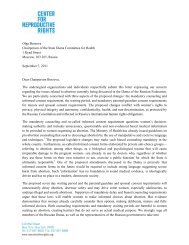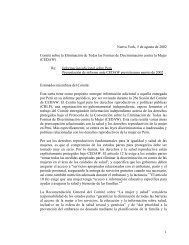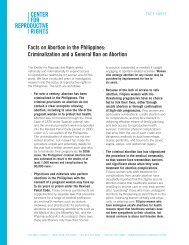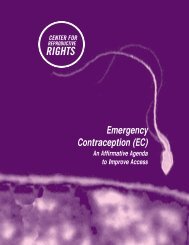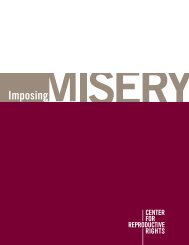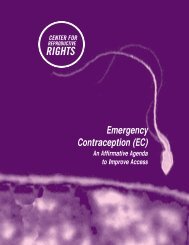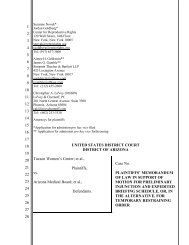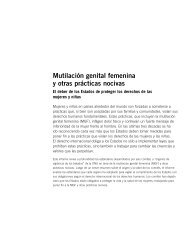Pregnant Women Living with HIV/AIDS: - Center for Reproductive ...
Pregnant Women Living with HIV/AIDS: - Center for Reproductive ...
Pregnant Women Living with HIV/AIDS: - Center for Reproductive ...
You also want an ePaper? Increase the reach of your titles
YUMPU automatically turns print PDFs into web optimized ePapers that Google loves.
<strong>Pregnant</strong> <strong>Women</strong> <strong>Living</strong> <strong>with</strong> <strong>HIV</strong>/<strong>AIDS</strong><strong>HIV</strong>/<strong>AIDS</strong> and its Toll on <strong>Women</strong>Heterosexual women are the group showing the greatest increases in prevalence of<strong>HIV</strong>/<strong>AIDS</strong>. UN<strong>AIDS</strong> estimates that, in sub-Saharan Africa, women are more likely—atleast 1.3 times—to be infected <strong>with</strong> <strong>HIV</strong> than men. Among younger age-groups, suchas those aged 15–24 years, women are three times as likely to be infected as men. InEastern Europe, rates of infection are rising among women: In Russia, the country inthe region hardest hit by the pandemic, 38% of the newly diagnosed <strong>HIV</strong> cases in 2003were among women, compared <strong>with</strong> 24% in 2001. Asia is also seeing increases in thenumber of women living <strong>with</strong> <strong>HIV</strong>/<strong>AIDS</strong>, <strong>with</strong> <strong>HIV</strong> transmission between spouses becominga more prominent mode of transmission than in the past. In the United States,African-American women account <strong>for</strong> an increasing share of new infections, and <strong>AIDS</strong>has become one of the three leading causes of death among African-American womenaged 35–44.Source: UN<strong>AIDS</strong> & WHO, <strong>AIDS</strong> EPIDEMIC UPDATE DECEMBER 2004 7–9 (2004),available at http://www.unaids.org/wad2004/report.html.I. BackgroundA. DISCRIMINATION AGAINST WOMEN AND <strong>HIV</strong>/<strong>AIDS</strong>Commentators have long pointed to the nexus between <strong>HIV</strong>/<strong>AIDS</strong> and gender discrimination.4 <strong>Women</strong> are physiologically more susceptible than men to <strong>HIV</strong> infection throughunprotected vaginal intercourse, 5 and the vast majority of women living <strong>with</strong> <strong>HIV</strong> areinfected in this way. <strong>Women</strong>’s physiological vulnerability to <strong>HIV</strong> infection is compoundedby pervasive sexual and domestic violence, and by women’s entrenched social andeconomic inequality <strong>with</strong>in their marriages and intimate relationships. 6 <strong>HIV</strong> transmissionbetween spouses is becoming more prevalent and there are indications that marriedwomen have a higher risk of infection than unmarried women. For example, adolescentbrides in some African countries are being infected <strong>with</strong> <strong>HIV</strong> at a higher rate than theirsexually active unmarried counterparts. 7<strong>Women</strong> have also suffered disproportionately from discrimination against people living<strong>with</strong> <strong>HIV</strong>/<strong>AIDS</strong>. The pandemic has led to increased gender-based violence as <strong>HIV</strong>-positivewomen are assaulted, prevented from having children, dismissed from employment,disowned, shunned by their families and communities, and sometimes even killed. 8<strong>Women</strong> are more likely than men to be held responsible <strong>for</strong> spreading the disease and tobe labeled as promiscuous. 9 Fearing violence, stigma, and ostracism, many women avoidtaking <strong>HIV</strong> tests, thereby denying themselves crucial in<strong>for</strong>mation about their health andexcluding themselves from programs to prevent <strong>HIV</strong> transmission to their newborns. 102 August 2005


